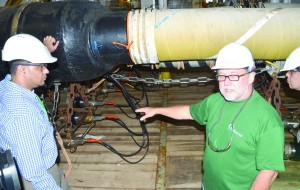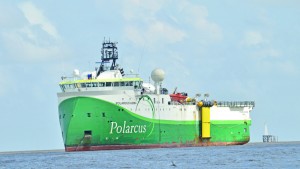
In its quest to discover oil in Guyana, Spanish oil exploration giant Repsol has invested US$ 35 million to carry out a 2D and 3D seismic survey in the Kanuku Block.
Seismic vessel, the Polarcus Asima, has been hired by the company to do the surveys. The vessel which arrived in Guyana last week is outfitted with state-of-the-art equipment and manned by a crew of 58 competent persons.
During a tour of the vessel on Saturday, Repsol Atlantic Basins Exploration Manager Allan Kean said the company will take advantage of the old data shot in 2008 in the area, merge it with the new data gained and reprocess it altogether to hopefully get the highest imaging resolution possible so that it could identify the location most likely to have oil.
After the final results, Repsol will then decide if it will invest another US$ 200 million to drill a well in the identified area.
Kean stated that it will take about nine months for the final processing of the data, adding that “by the end of next year 2014, we will know what direction we will be taking”.
He said this bit of information will help to make recommendations to the upper hierarchy of Repsol to determine whether to move forward. Repsol will also be receiving daily report on the progress of works from the Polarcus so that it can monitor developments.
One step closer
Meanwhile, Natural Resources and the Environment Minister Robert Persaud, who was present at the tour, said the initiative is a step closer to discovering oil in Guyana, which studies have shown has a high possibility.

The minister said he is happy that there is now mobilisation of the vessel, which he noted has some of the best technologies in the business. “The key for us is seeing early action because with seismic examination and processing of the data, this will then inform whether or not to drill and where are the targets… we hope the time frame will be kept.”
He commended the company for moving rapidly in its pursuit, noting that the latest development has come shortly after the company signed another agreement with the Guyana government to commence drilling for oil and gas in the Kanaku Basin offshore Guyana.
Repsol’s new Petroleum Prospecting Licence and its accompanying Production Sharing Agreement signed in May covers an area approximately 6525 square kilometres within the sedimentary basin offshore Guyana, and approximately 100 miles seawards of the mouth of the Berbice River.
At the signing, Repsol representatives had expressed the company’s anxiousness to commence work and had highlighted that the first phase includes the new 2D and 3D marine seismic acquisition, to be followed by an exploration well in the second phase of the licence which has been granted for an initial period of four years.
In July 2012, Repsol had to halt works at its Jaguar-1 well in the Georgetown Block due to safety issues.



